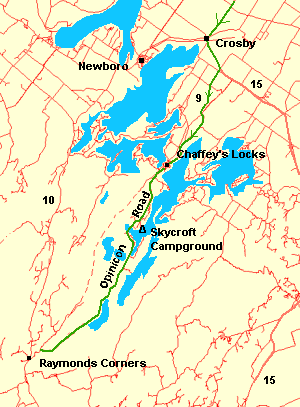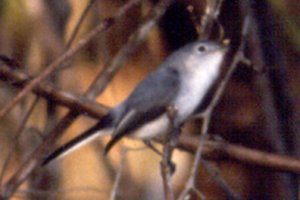CHAFFEY'S LOCKS
Spring: **** Summer: **** Fall: ** Winter: *
Independent Directions to this Site: Chaffey's Locks is about 2 hours southwest of Ottawa by car. Take Highway 417 west to the Highway 7 exit (145), then take the Hwy 7 exit to the right or west. Follow it over the 417 and head south on Hwy 7. Drive 20 kilometres southwest to Carleton Place and Highway 15. Turn left or SSE on Hwy 15 and go a further 62 kilometres through Smith's Falls, Portland and Crosby to County Road 9 or Opinicon Road. Turn right or SSW onto CR 9 and proceed 8 km to Chaffey's Locks.
Site Description and Birding Information: Continue on the Opinicon Road going west from Chaffey's Locks. This stretch of backroad is a wonderful place for Ottawa birders to go to become familiar with breeding birds whose northernmost range extentions barely reach Ottawa. Some of these birds are fairly common here, such as Cerulean Warbler, Golden-winged Warbler, Yellow-throated Vireo and Blue-gray Gnatcatcher. Others such as Red-shouldered Hawk, Yellow-billed Cuckoo, Eastern (Rufous-sided) Towhee and Red-headed Woodpecker are also found here in smaller numbers. Some birds are more common here than in the Ottawa area. Indigo Bunting, Scarlet Tanager and Pileated Woodpecker fall into this category.
From the locks it is 1.4 km to the road, on the left, to the Queens University Biological Station (QUBS). At 3.5 km from the locks you will pass from Leeds and Grenville into Frontenac County. At the 5.5 km mark from the locks you will have reached the main entrance to the Skycroft Campground.
Cerulean Warblers are common near the Skycroft Campground. Yellow-throted Vireos are common, but, like Ceruleans, stay high up and are difficult to see. There are trails (see map) opposite the Skycroft Campground, 6 km from Chaffey's Locks. This is one of the best birding areas. Yellow-billed Cuckoos are sometimes found near the small parking area. In May 2002, a Louisiana Waterthrush was heard singing near the Skycroft Campground. A small colony of Prairie Warblers was found in this area for many years, but not since 1999. Other species becoming less common in the area are Red-headed Woodpecker and Blue-winged Warbler. South of the campground, on the Opinicon Road, check the open area with two nesting boxes (on the right) for Golden-winged Warblers.
Continuing south on Opinicon Road you will come to the Pangman Conservation Reserve, a private study area of the Queens University Biological Station. The gated Lindsay Trail goes through tall trees that are good for Yellow-throated Vireos. This trail passes fields where Golden-winged Warblers are common, forest where Wood Thrush is found, and an area of small pines where Eastern Towhee can be found. The trail brings you to a small but beautiful lake with a sparse Mossy-cup oak forest, excellent for Blue-gray Gnatcatchers some years. QUBS requires users to get permission (normally given) prior to using the trail (phone: 613-359-5629 - Frank Phelan or Floyd Connor or Bruce Tufts). They also request birders and photographers refrain from using taped calls in the area, as bird song studys are being carried out there. Further information can be found on the QUBS website. Note that the QUBS web site now has a blog that lists rare sightings.
Going south, watch for the "Post Office Road" on the left, good for Blue-gray Gnatcatchers and Eastern Tohwees. Next you pass a study area for Tree Swallows, on the right. Stop at the small cemetery and look for Eastern Bluebirds, Bobolinks and Red-shouldered Hawks. You can sometimes hear the hawks calling. Then cross the Opinicon Road and take the trail behind the old barn. There one can see Eastern Phoebe, Brown Thrasher, Black-billed Cuckoo, Broad-winged Hawk and Red-shouldered Hawk.
Return to Favourite Outlying Sites.
Return to Birding Ottawa Table of Contents.
|
 Map of Chaffey's Locks Area
Map of Chaffey's Locks Area
 Blue-gray Gnatcatcher
Blue-gray Gnatcatcher
|

